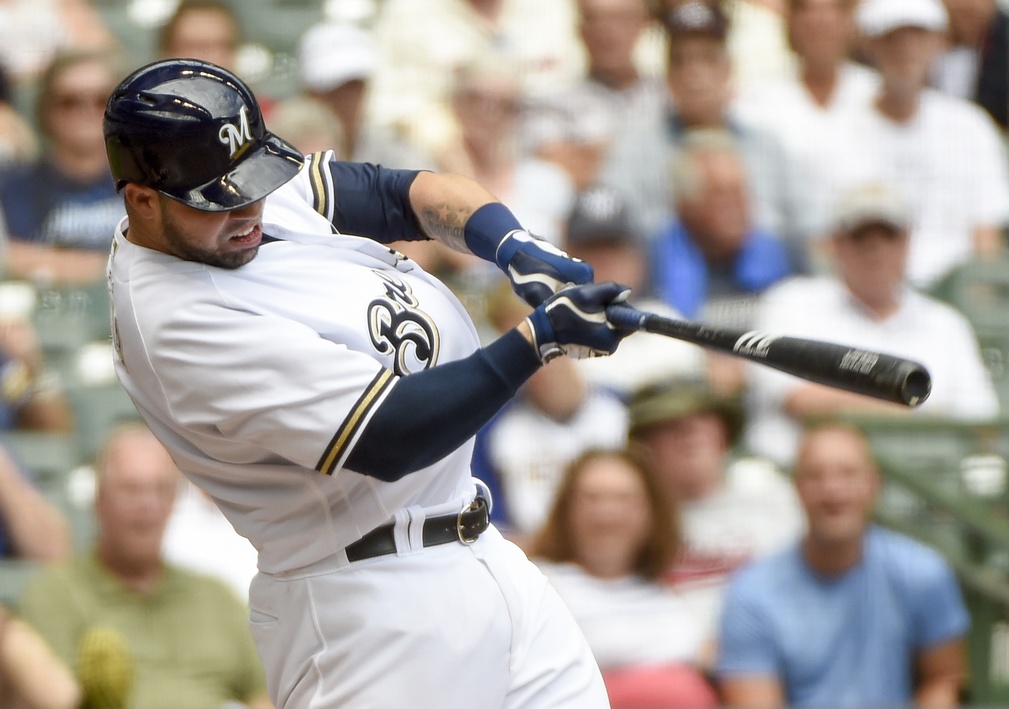As a rebuilding club should, the Brewers have played the 2016 season with one principal goal in mind: Throw a ton of unproven players onto the field, and see what happens. Players such as Jonathan Villar, Zach Davies, and Junior Guerra have each had the consistency and skill to hold on. On the flipside, Ramon Flores, David Goforth, and others have stunk up Miller Park. Milwaukee should keep this up during the stretch run — Orlando Arcia should stick, and other prospects will likely join him when rosters expand in a couple of weeks.
If Manny Pina is anything, he’s unproven. The 29-year-old backstop has now batted 41 times in the big leagues, after amassing 3,075 plate appearances in the minors. At the latter level, he posted an uninspiring .262/.330/.385 triple-slash, which makes his current batting line of .368/.500/.579 seem like a total fluke. That may not be the case, however, as Pina’s profile suggests he has some chance of sustaining this.
There’s first the matter of Pina’s minor-league career, which we can divide into two sections — pre-2015, and 2015-present:
| Years | AVG | OBP | SLG |
|---|---|---|---|
| Pre-2015 | .250 | .317 | .364 |
| 2015-Present | .316 | .372 | .483 |
Last season, Pina broke out with Detroit’s Triple-A affiliate, the Toledo Mud Hens. When the Tigers sent him to the Brewers in the Francisco Rodriguez deal, he didn’t miss a beat, continuing to flatten the competition at Colorado Springs. Pina recently explained to the Milwaukee Journal-Sentinel‘s Tom Haudricourt what allowed him to break out:
“[A] lot of it is in my mind,” he said Saturday. “I also worked on my stance, my hands, tried to change a couple of things. That was working really good and in winter ball I did very good. I took that to spring training this year and had a good season.
“Some of it was physical with my stance. I kept my hands back, didn’t move them too much. That worked for me. Then it helped my confidence. I stayed with the plan I had and I see the results.”
Although untrained, my eye can confirm those assertions. Compare these two swings, the first one from 2014…
…and the second from last week:
In the latter GIF, Pina takes a wider stance, with his back foot further from the plate. His stance also looks more vertically compact for the first homer, whereas he doesn’t bend his knees as much in the second. The result? A theoretically smoother swing, and perhaps a more dangerous bat.
Pina has had only 17 balls in play for the Brewers this season; we can’t conclude anything from a sample that tiny. He has seen 103 pitches, though, and those reveal another interesting trend. Pina has swung at an 64.0 percent of pitches inside the strike zone, according to FanGraphs’ PITCHf/x data; that lines up pretty neatly with the major-league average of 63.8 percent. He’s combined that with a refusal to chase, swinging at a mere 14.0 percent of pitches outside the confines of the zone.
Just how rare is that combination? Take a look at the lowest O-Swing rates among players with average or better Z-Swing rates:
| Rank | Name | Pitches | O-Swing% (pfx) | Z-Swing% (pfx) |
|---|---|---|---|---|
| 1 | Manny Pina | 104 | 14.0% | 65.2% |
| 2 | Omar Narvaez | 142 | 15.9% | 71.0% |
| 3 | Matt Joyce | 910 | 16.4% | 63.9% |
| 4 | Eric Fryer | 395 | 20.0% | 70.1% |
| 5 | Paul Janish | 127 | 20.0% | 66.2% |
Minimum 100 pitches
In this regard, Pina finds himself the best hitter in baseball. Combine a discerning eye with an ability to make contact — Pina has swung and missed at just 5.8 percent of the pitches he’s seen this year — and you get a steady hitter who piles up walks while dancing around strikeouts. No matter what kind of contact he makes, Pina’s plate discipline should ensure a role on offense.
Sadly for Pina, he doesn’t match his talents at the plate when he crouches behind it. In Triple A this season, Pina (along with teammate Josmil Pinto) was awful at framing pitches, and that ineptitude hasn’t gone away in the majors. Even though he throws out a fair share of base stealers, his sickly receiving will always make him a defensive liability. But with this kind of bat, he could see regular playing time, perhaps as a designated hitter.
This story — of the Brewers calling up an aging, little-known player, and him excelling down the stretch — happened last year as well. Jason Rogers had, essentially, one great month in Milwaukee, and the club capitalized on it: They traded him to Pittsburgh in exchange for Keon Broxton. Should Pina maintain this into September, the Brewers might flip him to an American League team, and as with Rogers, they could receive a valuable player in return.
In that JS article, Craig Counsell promised that, despite Pina’s play thus far, Martin Maldonado should remain the starting catcher for the remainder of the season. The veteran has played better in 2016 than he did in the preceding year, but at this point in his career, he’s likely reached his ceiling. Pina, on the other hand, is more of an unknown. We don’t know if he’ll stick; we do know that the fourth-place Brewers can afford to gamble on him.
